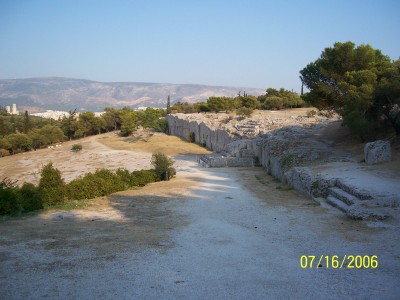|
The content on this website is maintained by
Robert Myallis, pastor at Zion's Lutheran Church, of Jonestown, PA.
The photos were taken by
Emily Myallis, a diaconal minister in the ELCA who also serves at Zion's Lutheran.
This website and travel to
Greece was made possible by a grant from the
Fund for Theological Education,
which provides grants to assist the education and formation of
Christian leaders from numerous denominations.
Bible quotes are taken from the New
Revised Standard Version, unless cites otherwise.
The above photo of Greece comes from
NASA; The icon of Saint Paul comes from George Mitrevski's website. |
 |
|
Pynx

Located near the Acropolis in Athens, the
Pynx is rightfully called the home of Democracy. It is here
where the first democratic assembly meant. (Admittedly, it was
not a full democracy as it limited participation to male
citizens.) As the number of voters increased overtime, the
orientation of speeches at the pynx changed directions.
Originally speakers faced listeners on the top half, but later
on the bottom half. Here Pericles motivated the Athenians in
their war against the Spartans.
How is the Pynx significant for
understanding the world of Paul?
The word in Greek for this assembly was the ekklesia,
literally “called-out.” In order to have an assembly, citizens
were “called-out.” (Slaves would even be assigned to fetch
people in the city if the minimum number of people were not
present.) This is the same word that the early Christians
used to describe their community. While ecclesiology in
Christian theology often connotes a hierarchical structure or
the theology surrounding leadership in the church, the original
Greek term had nothing to do with hierarchy and everything to do
with democracy.
 How were Paul and the early church remixing their culture?
How were Paul and the early church remixing their culture?
What is also remarkable is that women often had these assemblies
in their houses, showing that early Christian assemblies were
more “democractic” than their secular cousins. Furthermore, the
New Testament makes it clear that slaves were part of the
church, showing the broad enfranchisement of the early Christian
ekklesia compared to its secular cousin.
source:
info on pynx:
sign at museum in Ancient Agora, Stoa of Attalus, July 2006.
|
|




 How were Paul and the early church remixing their culture?
How were Paul and the early church remixing their culture?